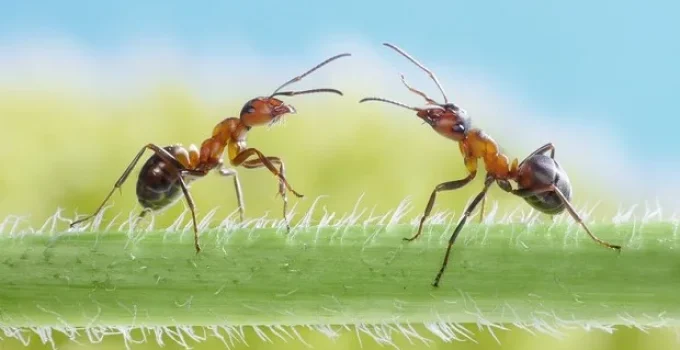How Do Ants Reproduce?
Ant reproduction is a highly organized, complex process that revolves around the division of labor and strict social roles within a colony. In short: ants reproduce sexually, with queens laying fertilized eggs after mating with male ants (drones). But the full answer involves mating flights, caste systems, pheromone control, and life cycles that vary between species.
🧭 Dive Deeper
- Ant Reproductive Castes
- The Nuptial Flight
- How Queens Store Sperm
- Development: From Egg to Adult
- Worker Reproduction: Can It Happen?
- 🎯 Final Thoughts
- 📚 References
Ant Reproductive Castes
Ant colonies consist of three main castes:
| Caste | Role | Reproductive Function |
|---|---|---|
| Queen | Colony founder and egg-layer | Fertile female |
| Male (Drone) | Mate with queens | Dies after mating |
| Worker | Foraging, defense, brood care | Sterile female (usually) |
- Queens are born with wings and are the only fertile females.
- Males are short-lived and exist solely for reproduction.
- Workers are female but sterile, though exceptions exist.
The Nuptial Flight
Ant reproduction begins with a dramatic event known as the nuptial flight, a synchronized mating ritual.
- Timing: Typically occurs on warm, humid days after rain.
- Flight: Virgin queens and males leave their colonies and take to the air.
- Mating in Mid-Air: Males mate with as many queens as possible before dying.
- Post-Mating: Queens land, shed their wings, and seek a nesting site.
📊 A single queen may mate with multiple males and store millions of sperm, which she uses throughout her life (which can last up to 30 years in some species) [1].
How Queens Store Sperm
After mating, the queen stores sperm in a special internal organ called the spermatheca.
- Long-Term Use: The queen can fertilize eggs for years or decades.
- Fertilized vs. Unfertilized:
- Fertilized eggs become females (workers or queens).
- Unfertilized eggs become males via haplodiploidy.
This ability gives the queen near-complete control over the colony’s population and sex ratio.
Development: From Egg to Adult
Ants undergo complete metamorphosis, meaning four distinct stages:
- Egg – Laid by the queen.
- Larva – Fed by workers.
- Pupa – Cocooned; transformation occurs.
- Adult – Emerges fully formed.
The caste of the female ant (queen or worker) is determined not by genetics, but by diet and pheromones during larval development.
| Stage | Duration (varies by species) |
|---|---|
| Egg to larva | 1–2 weeks |
| Larva to pupa | 1–2 weeks |
| Pupa to adult | 2–4 weeks |
📊 According to a study in Annual Review of Entomology, ant colonies can produce thousands of new ants per day during peak reproduction [2].
Worker Reproduction: Can It Happen?
Yes—in rare situations.
- In some species (like Cataglyphis), worker ants can lay unfertilized eggs that develop into males.
- In the absence of a queen, some workers may activate their ovaries, especially in species without strict queen suppression.
However, most colonies use pheromones to suppress worker reproduction, maintaining social order.
🎯 Final Thoughts
So, how do ants reproduce? Ant reproduction is an intricate system designed to ensure colony survival, flexibility, and expansion. Through the mating flight, long-term sperm storage, and caste-based control of development, ants have mastered reproductive efficiency. The queen may live for decades, producing millions of offspring from a single mating flight—one of the most remarkable feats in the insect world.
📚 References
- Hölldobler, B., & Wilson, E. O. (1990). The Ants. Harvard University Press.
- Tschinkel, W. R. (2006). The Fire Ants. Harvard University Press.
- Heinze, J., & Tsuji, K. (1995). Ant reproductive strategies. Researches on Population Ecology, https://doi.org/10.1007/BF02515418
- Keller, L., & Nonacs, P. (1993). The role of queen pheromones in social insects: Queen control or queen signal? Animal Behaviour, https://doi.org/10.1006/anbe.1993.1245
- University of California Agriculture & Natural Resources – Biology and Lifecycle – Colony Establishment. https://ipm.ucanr.edu/TOOLS/ANTKEY/biolcol.html
📌Learn More About Ants
- How Do Ants Reproduce?🐜A Deep Dive Into Colony Growth
- Do Ants Have Blood?🐜 The Surprising Truth about Insect Circulation
- Can Ants Smell? 🐜 Exploring the Chemical World of Ant Communication
- Can Ants Swim? 🐜 Exploring the Aquatic Abilities of Earth’s Hardest Workers
- Do Ants Eat Termites? 🐜 The Many Termite Predators
- Do Ants Have Brains? 🐜 Inside the Mind of Nature’s Minature Engineers
- Do Ants Have Muscles? 🐜 Explore What These Muscular Powerhouses Can Do
- Do Ants Sleep? 🐜 Ants Are Supersonic Power Nappers!
- How Long Do Ants Live? 🐜 A Look Into the Lifespan of the Colony
- What Do Ants Eat? 🐜 Inside the Pantry of an Ant Colony
- Are Ants Blind? 🐜How These Tiny Insects See the World
